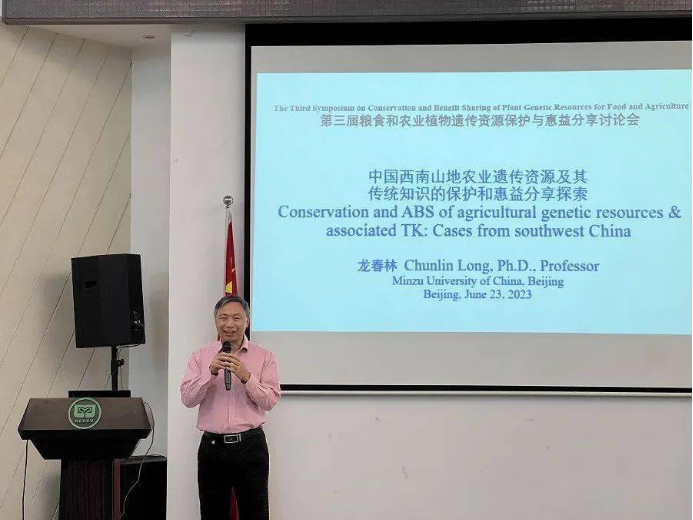Chunlin Long: Conservation and ABS of agricultural genetic resources & associated TK: Cases from southwest China
On May 23rd, 2023, China Biodiversity Conservation and Green Development Foundation (CBCGDF) and Beijing Academy of Agriculture and Forestry Sciences (BAAFS) jointly organized a symposium called the Third Symposium on Conservation and Benefit Sharing of Plant Genetic Resources for Food and Agriculture at the International Exchange Center of Vegetable Research Institute, BAAFS. Prof. Chunlin Long made a speech about “Conservation and ABS of agricultural genetic resources & associated TK: Cases from southwest China”.

Prof. Long shared three specific cases and introduced his experience in conserving genetic resources related to traditional knowledge in the southwestern region of China over the past few years.
The first case showed the staple food of the Dong ethnic group in Guizhou, called as Kam Rice of China or Kam Sweet Rice. Although people there mainly cultivated a few new species of rice promoted by the government, which reduced its diversity, there are still many old species in the local area. Playing many roles in various festivals and religious ceremonies of the local people, they have helped form various suitable agricultural ecosystems (rice - duckweed - fish - duck), diversified cultivation methods, low-fertilizer agricultural techniques, and seed management systems, thereby ensuring the diversity of food genetic resources.
The second case is that, for the Yi ethnic group in Liangshan, Sichuan, buckwheat is a very important crop in the local area. It has played an important role in various aspects such as traditional culture, literature and art, weddings and funerals, sacrifices, and religious beliefs.
The third case told people that "Changmao Grain" is a kind of rice, which is one of unique ancient and rare traditional species planted in the valley area of the Nujiang River in Yunnan. However, when discovered, it was only planted in an area of 200 acres. Therefore, by collaborating with local farmers and enterprises, Prof. Long developed a mechanism for protection, .conservation, utilization, and benefit sharing with the help of internet.
Finally, he concluded that these three cases have proven that traditional agricultural genetic resources have been preserved to varying degrees in ethnic minority areas. Of course, the benefit sharing of these resources is still in a very early stage, but these cases could provide us with some inspiration and thinking. Both traditional genetic resources and related traditional knowledge are actually in a very endangered state. We need to do a lot of work to rescue and explore benefit sharing, thereby promoting protection.
Translator: Richard
Editor: Daisy
Contact: V10@cbcgdf.org; +8617319454776

Contribution
Do you know? CBCGDF is a non-profit organization. We rely on crowd-funding and donations. You have the opportunity to help us to advance biodiversity conservation. Donate TODAY to power up the movement to make it a better world for all life.

.jpg)

Comments
Post a Comment